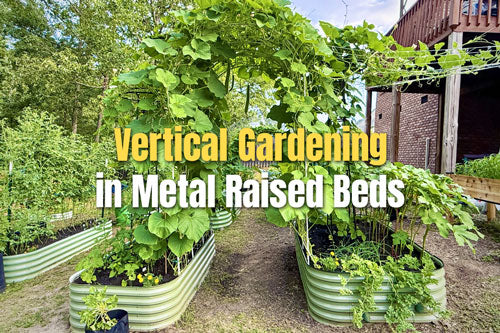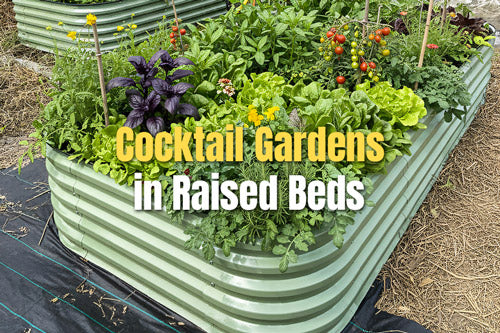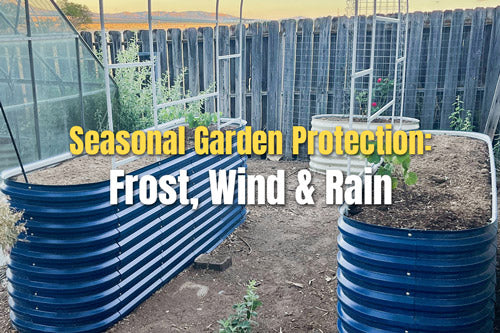How to Winterize Raised Garden Beds
What do you do with your metal raised garden beds when you don't continue planting in the fall? As the growing season comes to an end, cleaning and preparing your garden bed for winter is more conducive to spring planting. Planting in a garden bed during the wet spring is a hard task. That's why fall is the best time to do fall chores for your wooden garden beds or metal garden beds.Let them continue to build you a fruitful garden in the spring after a few months of rest and recuperation. Here are six tasks you should do for your raised garden beds.
What do you do to Winterize Raised Garden Beds
1. Remove dead plants from metal raised beds
Autumn is an excellent time to remove any dead plants from your garden beds. The plants will not continue to grow, but those remaining in the garden bed provide an opportunity for pests and diseases to take advantage of the bed. When cleaning your raised beds, the plants roots should be removed. The best way to do this is to till the soil with garden forks. You will not only completely remove some of the plant roots and weeds during this process, but you will also prevent some bugs from snapping into the soil. Clearing your raised beds will help reduce weeds and diseases, as well as pest and rodent infestations.
2. Clean your metal garden beds
Cleaning your metal garden beds can make your garden look neater and cleaner and prevent pests from climbing into your garden beds over the winter. The soil accumulating on the metal panels adds roughness, allowing some slugs or bugs to crawl inside the bed, whereas clean and smooth metal panels can avoid this situation. Vegega metal raised garden beds are simple to clean by rinsing with water. Other tools or detergents are not required.
By the way, Vegega's metal garden beds come in a variety of sizes, including 9-in-1, 6-in-1, 4-in-1, and 2-in-1. So, the metal garden bed you used can be assembled in a variety of ways. Why don't you take this time to dismantle the garden bed and reassemble it in different sizes to change the layout of your garden? As demonstrated in the video below.
3. Add filler for metal garden beds
We usually fill our raised garden beds with biodegradable organic materials. As the fillers are consumed over time, we should add new organic materials. Autumn is a good time to add new filler because it will provide a nutrient-rich growing environment in the spring. In autumn, your garden is full of ready-made fillers. Leaves and branches are all excellent fillers. It is important to note that the filler used in the garden bed must be organic and healthy. Anything with pest or disease potential should not be put in.

4. Compost in the metal garden beds
Composting is a method of recycling that is used in almost every household. Composting directly in the bed is one of the advantages of using metal raised garden beds. The environment inside the bed is a natural composting site. Food waste, garden branches, leaves, and fruits (choose branches and leaves that are free of pests and diseases, and do not put weed seeds into the compost) are chopped up and laid out 1-2 inches in the garden bed, then covered with a thick layer of soil to build a composting environment. After a winter of fermenting the compost, the garden bed can be directly planted in the spring.
Related article: The Ultimate Guide to Composting.

5. Amend the soil in metal garden beds
No matter how full your garden beds are when you fill them, you will notice that the soil is diminishing or sinking as you grow plants. This is because the organic matter in the soil is constantly decomposing to provide nutrients for absorption by the plants. Soil conservation is a scientific approach. In addition to add potting mix, we can occasionally add biodegradable organic matter, organic fertilizer, and mulch to amend the soil in the bed to get a nutrient-rich soil environment.
Related article:
Soil Preparation Guide for Beginners.
How To Improve Soil pH In Raised Garden Beds.

6. Place a layer of mulch
Mulch is an excellent addition to your raised garden beds all year. It provides shade in the summer and frost protection in the winter. It's important to put mulch on your bed because it will protect your soil from wind, frost, rain, and snow. Winter rain has the potential to deplete soil nutrients and cause soil buildup. Mulch provides an additional layer of protection for the soil. Winter mulches that work well include bark chips, shredded bark, pine needles, and straw.
Related article: What to choose the organic mulch for your raised garden bed?
Conclusion
I hope this article has cleared up any confusion about the finishing tasks for the raised garden bed. Whether it's a metal garden bed or a wooden garden bed, it deserves to be treated with respect and care. I wish everyone's spring planting plans went smoothly!


